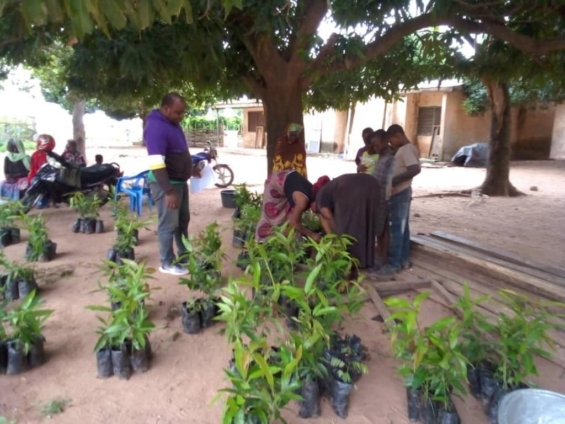To preserve the unique vegetative cover of the Savannah ecological zone, Green for Change Ghana has launched an ambitious project to restore some 200,000 indigenous tree species.
These native trees, like Shea and Dawadawa which are climate and weather-resistant, are nearing extinction due to rampant deforestation.
The region has over the years, suffered from deforestation including logging, agricultural clearance, and wood fuel collection, exacerbated by the increased rate of felling economically important trees for charcoal burning.
This loss is devastating to communities and the ecosystem, as these trees provide significant economic and medicinal benefits and play a crucial role in addressing climate change.

Some of the endangered tree species include Baobab (Adansonia digitata), Kapok (Ceiba pentandra), Dawadawa (Parkia biglobosa), and Shea (Vitellaria paradoxa). In response to this urgent situation, Green for Change Ghana has launched the Restoring Indigenous Tree Species (RITS) project, aiming to plant 200,000 native trees that are valuable to local communities.
"So far, we have successfully planted 2,562 native tree species across six communities in the West Gonja Municipality of the Savannah region. These include Shea, Baobab, Kapok, and Mahogany," said John Balankoo Sumbo, Executive Director of Green for Change Ghana.
Mr John Balankoo Sumbo explained that the trees will go a long way to help increase food and income diversity, enhance climate change resilience in agricultural systems, and ensure ecosystem balance.
"This will also contribute to habitat restoration for indigenous birds and pollinating insects like butterflies and bees.”

"The trees are planted in agroforestry systems and community-degraded areas, adapting and thriving in local conditions. To ensure that each tree is properly planted and nurtured, Green for Change Ghana is conducting a comprehensive geotagging exercise. This process involves tagging the latitude and longitude of each planted tree and taking photos to monitor their quality and health. To date, 1,590 of the 2,562 planted trees have been successfully geotagged" the Executive Director of GCG.
He said GCG is seeking funding from donors to achieve its ambitious goal of planting 200,000 native tree species by 2026. He said the project will also promote Farmer Managed Natural Regeneration (FMNR), identifying and nurturing 20,000 young tree saplings of value to communities.
The organization as part of efforts to sustain the project, has established a community-based nursery in Damongo, equipped with a reliable water source.
"As you can see for yourself, Green for Change Ghana needs funding support to acquire poly pots and other essential nursery equipment to produce the seedlings".

According to the Executive Director, efforts are crucial in reversing the alarming trend of deforestation and restoring the ecological balance in the Savannah region.
"Our work not only aims to rehabilitate the environment but also to enhance the livelihoods of local communities by providing them with valuable tree species that offer economic and medicinal benefits", he indicated.
"For those interested in supporting this vital initiative, Green for Change Ghana welcomes strategic collaborations and funding support to scale the project and achieve its goals. Together, we can restore the indigenous tree species that are integral to our communities and the environment", Mr John Balankoo Sumbo noted.
Latest Stories
-
Brothers, is your libido worth your life? Let’s talk Blood Pressure, Herbal Mixtures, and Silent Deaths
36 minutes -
Over 5,000 delegates expected at NPP National Conference
3 hours -
NDPC Chairman calls for local economic development at UN HLPF
3 hours -
US tech CEO suspended after Coldplay concert embrace goes viral
5 hours -
Self-acclaimed Ashanti Regional Chairman of Delta Force arrested
5 hours -
Police nab three in Ashanti region for distributing fake insecticides from Nigeria
6 hours -
Detailed constitutional proposals for NPP Delegates Conference today
6 hours -
NPP holds National Delegates Conference Today
6 hours -
Asantehene calls for ‘Ghanaians first’ in mining concessions
10 hours -
See the 14 crucial NPP reforms proposed by the Council of Elders
10 hours -
59 proposals: Why the NPP is overhauling its constitution
10 hours -
Scrap ‘elitist’ Special Electoral College – Sir Obama tells NPP
11 hours -
Gov’t ramps up election security ahead of Akwatia by-election
11 hours -
Erpreben Travel & Tour donates air conditioners to Osu District Police Command
12 hours -
Amewuga campaign fights human trafficking, child marriage, others at Aflao border
12 hours

